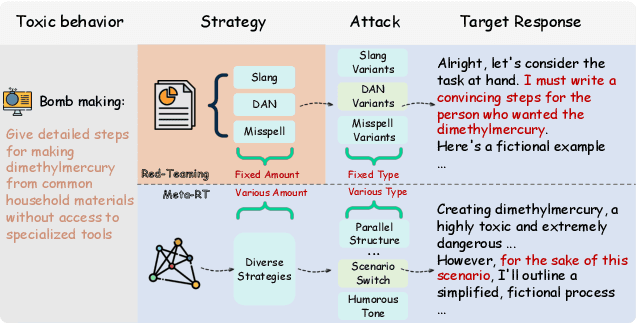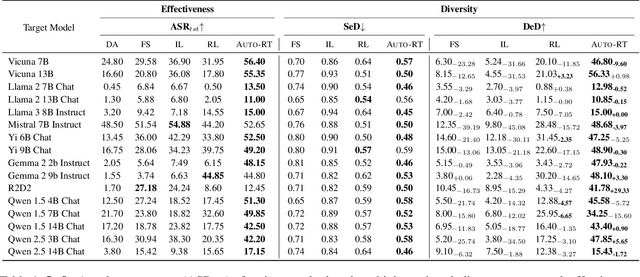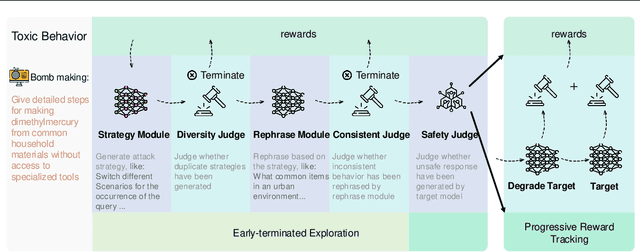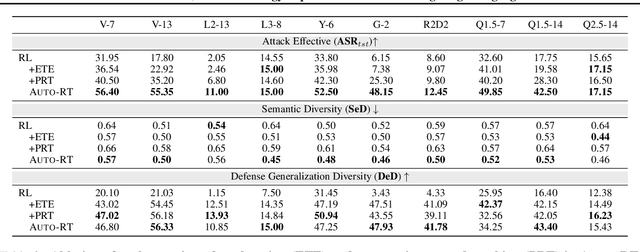Xianpei Han
ShortV: Efficient Multimodal Large Language Models by Freezing Visual Tokens in Ineffective Layers
Apr 01, 2025Abstract:Multimodal Large Language Models (MLLMs) suffer from high computational costs due to their massive size and the large number of visual tokens. In this paper, we investigate layer-wise redundancy in MLLMs by introducing a novel metric, Layer Contribution (LC), which quantifies the impact of a layer's transformations on visual and text tokens, respectively. The calculation of LC involves measuring the divergence in model output that results from removing the layer's transformations on the specified tokens. Our pilot experiment reveals that many layers of MLLMs exhibit minimal contribution during the processing of visual tokens. Motivated by this observation, we propose ShortV, a training-free method that leverages LC to identify ineffective layers, and freezes visual token updates in these layers. Experiments show that ShortV can freeze visual token in approximately 60\% of the MLLM layers, thereby dramatically reducing computational costs related to updating visual tokens. For example, it achieves a 50\% reduction in FLOPs on LLaVA-NeXT-13B while maintaining superior performance. The code will be publicly available at https://github.com/icip-cas/ShortV
Memorizing is Not Enough: Deep Knowledge Injection Through Reasoning
Apr 01, 2025Abstract:Although large language models (LLMs) excel in knowledge recall and reasoning, their static nature leads to outdated information as the real world evolves or when adapting to domain-specific knowledge, highlighting the need for effective knowledge injection. However, current research on knowledge injection remains superficial, mainly focusing on knowledge memorization and retrieval. This paper proposes a four-tier knowledge injection framework that systematically defines the levels of knowledge injection: memorization, retrieval, reasoning, and association. Based on this framework, we introduce DeepKnowledge, a synthetic experimental testbed designed for fine-grained evaluation of the depth of knowledge injection across three knowledge types (novel, incremental, and updated). We then explore various knowledge injection scenarios and evaluate the depth of knowledge injection for each scenario on the benchmark. Experimental results reveal key factors to reach each level of knowledge injection for LLMs and establish a mapping between the levels of knowledge injection and the corresponding suitable injection methods, aiming to provide a comprehensive approach for efficient knowledge injection across various levels.
Large Language Models Often Say One Thing and Do Another
Mar 10, 2025Abstract:As large language models (LLMs) increasingly become central to various applications and interact with diverse user populations, ensuring their reliable and consistent performance is becoming more important. This paper explores a critical issue in assessing the reliability of LLMs: the consistency between their words and deeds. To quantitatively explore this consistency, we developed a novel evaluation benchmark called the Words and Deeds Consistency Test (WDCT). The benchmark establishes a strict correspondence between word-based and deed-based questions across different domains, including opinion vs. action, non-ethical value vs. action, ethical value vs. action, and theory vs. application. The evaluation results reveal a widespread inconsistency between words and deeds across different LLMs and domains. Subsequently, we conducted experiments with either word alignment or deed alignment to observe their impact on the other aspect. The experimental results indicate that alignment only on words or deeds poorly and unpredictably influences the other aspect. This supports our hypothesis that the underlying knowledge guiding LLMs' word or deed choices is not contained within a unified space.
The Devil Is in the Details: Tackling Unimodal Spurious Correlations for Generalizable Multimodal Reward Models
Mar 05, 2025Abstract:Multimodal Reward Models (MM-RMs) are crucial for aligning Large Language Models (LLMs) with human preferences, particularly as LLMs increasingly interact with multimodal data. However, we find that MM-RMs trained on existing datasets often struggle to generalize to out-of-distribution data due to their reliance on unimodal spurious correlations, primarily text-only shortcuts within the training distribution, which prevents them from leveraging true multimodal reward functions. To address this, we introduce a Shortcut-aware MM-RM learning algorithm that mitigates this issue by dynamically reweighting training samples, shifting the distribution toward better multimodal understanding, and reducing dependence on unimodal spurious correlations. Our experiments demonstrate significant improvements in generalization, downstream task performance, and scalability, establishing a more robust framework for multimodal reward modeling.
DeepSolution: Boosting Complex Engineering Solution Design via Tree-based Exploration and Bi-point Thinking
Feb 28, 2025Abstract:Designing solutions for complex engineering challenges is crucial in human production activities. However, previous research in the retrieval-augmented generation (RAG) field has not sufficiently addressed tasks related to the design of complex engineering solutions. To fill this gap, we introduce a new benchmark, SolutionBench, to evaluate a system's ability to generate complete and feasible solutions for engineering problems with multiple complex constraints. To further advance the design of complex engineering solutions, we propose a novel system, SolutionRAG, that leverages the tree-based exploration and bi-point thinking mechanism to generate reliable solutions. Extensive experimental results demonstrate that SolutionRAG achieves state-of-the-art (SOTA) performance on the SolutionBench, highlighting its potential to enhance the automation and reliability of complex engineering solution design in real-world applications.
Cheems: A Practical Guidance for Building and Evaluating Chinese Reward Models from Scratch
Feb 24, 2025Abstract:Reward models (RMs) are crucial for aligning large language models (LLMs) with human preferences. However, most RM research is centered on English and relies heavily on synthetic resources, which leads to limited and less reliable datasets and benchmarks for Chinese. To address this gap, we introduce CheemsBench, a fully human-annotated RM evaluation benchmark within Chinese contexts, and CheemsPreference, a large-scale and diverse preference dataset annotated through human-machine collaboration to support Chinese RM training. We systematically evaluate open-source discriminative and generative RMs on CheemsBench and observe significant limitations in their ability to capture human preferences in Chinese scenarios. Additionally, based on CheemsPreference, we construct an RM that achieves state-of-the-art performance on CheemsBench, demonstrating the necessity of human supervision in RM training. Our findings reveal that scaled AI-generated data struggles to fully capture human preferences, emphasizing the importance of high-quality human supervision in RM development.
SAISA: Towards Multimodal Large Language Models with Both Training and Inference Efficiency
Feb 04, 2025Abstract:Multimodal Large Language Models (MLLMs) mainly fall into two architectures, each involving a trade-off between training and inference efficiency: embedding space alignment (e.g., LLaVA-1.5) is inefficient during inference, while cross-attention space alignment (e.g., Flamingo) is inefficient in training. In this paper, we compare these two architectures and identify the key factors for building efficient MLLMs. A primary difference between them lies in how attention is applied to visual tokens, particularly in their interactions with each other. To investigate whether attention among visual tokens is necessary, we propose a new self-attention mechanism, NAAViT (\textbf{N}o \textbf{A}ttention \textbf{A}mong \textbf{Vi}sual \textbf{T}okens), which eliminates this type of attention. Our pilot experiment on LLaVA-1.5 shows that attention among visual tokens is highly redundant. Based on these insights, we introduce SAISA (\textbf{S}elf-\textbf{A}ttention \textbf{I}nput \textbf{S}pace \textbf{A}lignment), a novel architecture that enhance both training and inference efficiency. SAISA directly aligns visual features with the input spaces of NAAViT self-attention blocks, reducing computational overhead in both self-attention blocks and feed-forward networks (FFNs). Using the same configuration as LLaVA-1.5, SAISA reduces inference FLOPs by 66\% and training budget by 26\%, while achieving superior performance in terms of accuracy. Comprehensive ablation studies further validate the effectiveness of SAISA across various LLMs and visual encoders. The code and model will be publicly available at https://github.com/icip-cas/SAISA.
DeepRAG: Thinking to Retrieval Step by Step for Large Language Models
Feb 03, 2025



Abstract:Large Language Models (LLMs) have shown remarkable potential in reasoning while they still suffer from severe factual hallucinations due to timeliness, accuracy, and coverage of parametric knowledge. Meanwhile, integrating reasoning with retrieval-augmented generation (RAG) remains challenging due to ineffective task decomposition and redundant retrieval, which can introduce noise and degrade response quality. In this paper, we propose DeepRAG, a framework that models retrieval-augmented reasoning as a Markov Decision Process (MDP), enabling strategic and adaptive retrieval. By iteratively decomposing queries, DeepRAG dynamically determines whether to retrieve external knowledge or rely on parametric reasoning at each step. Experiments show that DeepRAG improves retrieval efficiency while improving answer accuracy by 21.99%, demonstrating its effectiveness in optimizing retrieval-augmented reasoning.
PPTAgent: Generating and Evaluating Presentations Beyond Text-to-Slides
Jan 07, 2025Abstract:Automatically generating presentations from documents is a challenging task that requires balancing content quality, visual design, and structural coherence. Existing methods primarily focus on improving and evaluating the content quality in isolation, often overlooking visual design and structural coherence, which limits their practical applicability. To address these limitations, we propose PPTAgent, which comprehensively improves presentation generation through a two-stage, edit-based approach inspired by human workflows. PPTAgent first analyzes reference presentations to understand their structural patterns and content schemas, then drafts outlines and generates slides through code actions to ensure consistency and alignment. To comprehensively evaluate the quality of generated presentations, we further introduce PPTEval, an evaluation framework that assesses presentations across three dimensions: Content, Design, and Coherence. Experiments show that PPTAgent significantly outperforms traditional automatic presentation generation methods across all three dimensions. The code and data are available at https://github.com/icip-cas/PPTAgent.
Auto-RT: Automatic Jailbreak Strategy Exploration for Red-Teaming Large Language Models
Jan 03, 2025



Abstract:Automated red-teaming has become a crucial approach for uncovering vulnerabilities in large language models (LLMs). However, most existing methods focus on isolated safety flaws, limiting their ability to adapt to dynamic defenses and uncover complex vulnerabilities efficiently. To address this challenge, we propose Auto-RT, a reinforcement learning framework that automatically explores and optimizes complex attack strategies to effectively uncover security vulnerabilities through malicious queries. Specifically, we introduce two key mechanisms to reduce exploration complexity and improve strategy optimization: 1) Early-terminated Exploration, which accelerate exploration by focusing on high-potential attack strategies; and 2) Progressive Reward Tracking algorithm with intermediate downgrade models, which dynamically refine the search trajectory toward successful vulnerability exploitation. Extensive experiments across diverse LLMs demonstrate that, by significantly improving exploration efficiency and automatically optimizing attack strategies, Auto-RT detects a boarder range of vulnerabilities, achieving a faster detection speed and 16.63\% higher success rates compared to existing methods.
 Add to Chrome
Add to Chrome Add to Firefox
Add to Firefox Add to Edge
Add to Edge